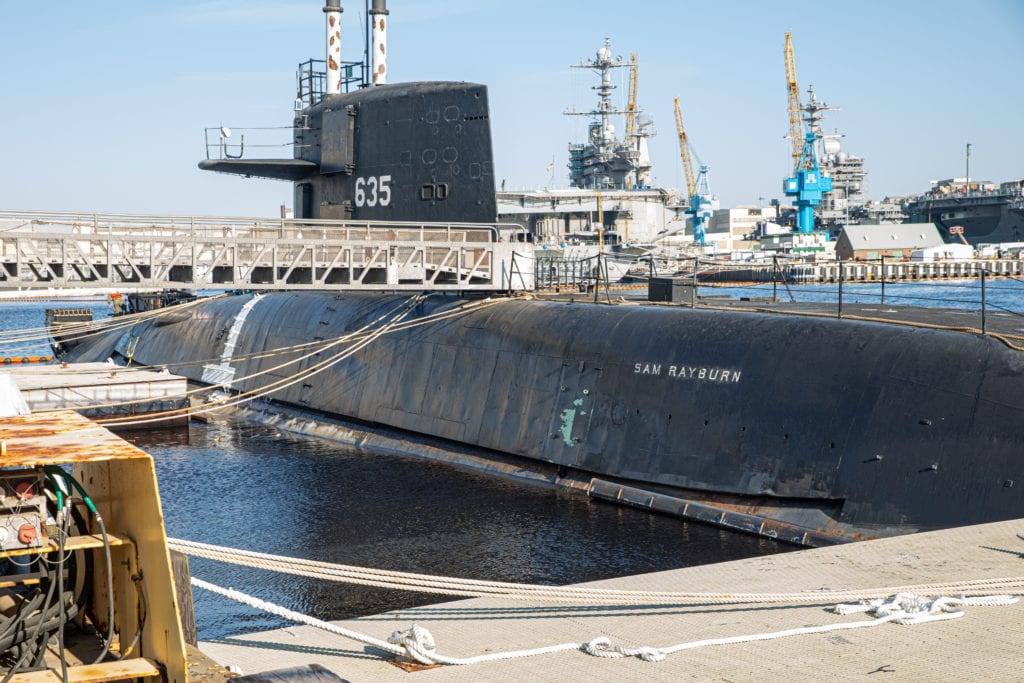
NORFOLK, Va. — Norfolk Naval Shipyard (NNSY) welcomed the Moored Training Ship Sam Rayburn (MTS 635) April 3 in advance of its inactivation.
Rayburn (formerly SSBN 635) served as a MTS at Nuclear Power Training Unit – Charleston for more than 30 years training Sailors in the operation, maintenance and supervision of nuclear propulsion systems. Along with MTS Daniel Webster (MTS 626), Rayburn is being replaced by the next-generation training vessels MTS La Jolla (MTS 701) and USS San Francisco (SSN 711).
Providing unique opportunity for the NNSY workforce, Rayburn marks the Navy’s first inactivation of a MTS. Upon completion of this work, Rayburn will be towed to Puget Sound Naval Shipyard for recycling. NNSY will also perform Webster’s inactivation.
“USS Sam Rayburn has proudly served the U.S. Submarine Force and Navy Nuclear Propulsion Program since 1964, and we now welcome it to America’s Shipyard,” said Shipyard Commander Capt. Dianna Wolfson. “Performing the first inactivation of a Moored Training Ship will develop another important facet in our service to the fleet, and we look forward to excelling in our mission as one team.”
Throughout Rayburn’s three-decade stint as a training vessel, NNSY has performed maintenance on it as needed, sometimes in Portsmouth when a dry docking was required, and other times onsite in Charleston, sending upwards of 200 employees to perform Pierside Extended Maintenance Availabilities and support depot level repairs during continuous maintenance availabilities.
Commending Norfolk Naval Shipyard’s Charleston (NNSY-CHS) team for its record of planned maintenance and emergent repairs, Adm. James Caldwell, director, Naval Reactors, said, “NNSY-CHS’s efforts directly contributed to the Naval Nuclear Propulsion Training Program’s (NNPTP) ability to meet or exceed annual fleet requirements for qualified operators for the past several years, allowing the nuclear Navy to achieve 100 percent fleet manning for the first time in 10 years. This recognition speaks to the direct leadership, dedication and follow through of a passionate team striving for consistent impactful results.”
During this time of modernization for the NNPTP, the NNSY-CHS team has been concurrently working retirements of Rayburn and Webster; delivering and supporting work of the new vessels; and modernizing the site to enhance future training needs.
“Preparing and towing the MTS 635 represents the next step in modernizing the nuclear training program here in Charleston,” said MTS Project Superintendent Chrystal Brady. “By retiring the MTS 635, NPTU Charleston can move forward with the final preparations to receive the MTS 711 later this year. The NNSY Charleston team continues to demonstrate dedication to the mission of the site. To care for and deliver this asset, many personal sacrifices have been made over the years to deliver on maintenance schedules and, most recently, to ensure an on-time tow. Our team takes great pride in the way we represent NNSY and the Navy every day.”
Exemplifying Wolfson’s “One Mission-One Team” mantra, sending Rayburn to Portsmouth required constant communication and coordination between NNSY and its Charleston team hundreds of miles away. “There were several key parts to this plan for Norfolk Naval Shipyard — the safe departure from Charleston, tow, and safe arrival at Norfolk Naval Shipyard,” said Pat Ensley, NNSY Submarine program manager. “This was a great team effort to accomplish this mission. The detailed preparations for departure took significant planning and execution to complete the preparations for tow.”
Following La Jolla, which completed its conversion at NNSY in November 2019, San Francisco is now in the final stages of becoming a Moored Training Ship for towing to Charleston. These conversions are the closest NNSY has come to new ship construction since the 1950s, requiring two complete hull cuts, separating each boat into three pieces, recycling the center section, and adding three new hull sections, adding 76 feet to the overall length on both vessels.
This article is by Michael Brayshaw, NNSY Lead Public Affairs Specialist
- Red Sea Update - April 26, 2024
- U.S. Begins Construction on Temporary Pier to Deliver Humanitarian Aid to Gaza - April 26, 2024
- IKE Carrier Strike Group Arrives in the Eastern Mediterranean - April 26, 2024






